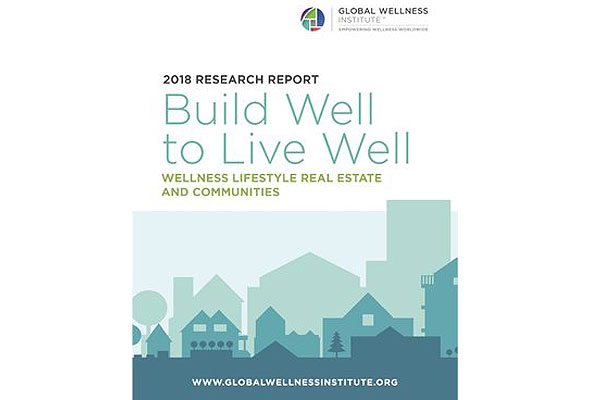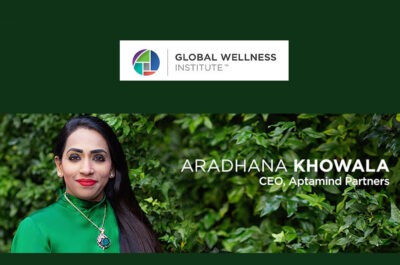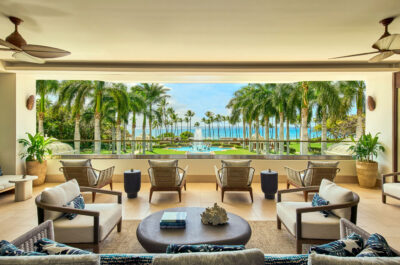First in-depth research to analyze the global wellness real estate and communities sector finds the market will grow fast: from $134 to $180 billion from 2017-2022 – with U.S. by far the largest market ($52.5 billion), followed by China, Australia and UK – and a current global pipeline of 740 projects that grows by the week.
NEW YORK, NY – The Global Wellness Institute (GWI) released its much-anticipated report “Build Well To Live Well”, the first research to size and analyze the global and regional wellness lifestyle real estate and communities market. The 150+ page report finds that real estate and communities that intentionally put people’s health at the center of design, creation and redevelopment are the next frontier in residential real estate. The global market is growing fast: over 6% a year from 2015-2022. Consumer demand for healthy homes is outstripping supply: in the U.S., for example, there are an astonishing 1.3 million potential buyers each year but with a pipeline of 355 projects – and that pipeline leads the world.
While the market is tipping from niche to mainstream, this report fills a major knowledge gap: few investors, developers, consumers, or policymakers understand what wellness lifestyle real estate and communities are – or should be. It’s packed with info: from data on global and regional market sizes, price premiums, and consumer demand – to case studies on the wildly diverse themes and business models – to studies documenting the impact on both human health and investor ROI – to a full global pipeline list – to regional trends – to tools that help execute successful projects: from the certification/design systems that support building “well” to a dashboard that can measure the human health impacts. Seven key trends that will shape this market’s future are also identified: from new developments that blur the line between home, work and wellness to the rise of multigenerational and affordable wellness communities.
“Collectively, we must shake up our thinking: healthy homes are as important as immunizations; parks, paths, and plants are as beneficial as prescriptions; friends and neighbors are far more important than Fitbits,” said Katherine Johnston GWI Sr. Research Fellow. “All the industries that create our home environments – real estate investors, urban planners/designers, architects, transportation planners, the construction industry – play a massive role in human health. And they need to partner to meet the desperate need – and fast-rising demand – for healthier homes and communities.”
Key Findings
Strong Market Growth
Wellness real estate grew 6.4% annually since 2015, to reach $134 billion in 2017, and will expand 6% yearly through 2022 to reach $180 billion. Comparison: that’s 1.5% of the annual global construction market, and half the size of the global green building industry ($260 billion). The U.S., along with a few key Asian countries (China, Australia, India) and Europe (UK, Germany), account for three-quarters of the market.
Each market is distinct. The U.S., the goliath, has seen projects proliferate in “Sun Belt” states (Arizona, Texas, Florida, South Carolina, Georgia, etc.) where “wellness living” has become a key differentiator in red-hot real estate markets; The U.S. also invented the “agrihood” concept (communities revolving around farms), and is a major innovator in urban, senior living, and affordable wellness concepts. Australia is also a trailblazer, but with more centralized, larger-scale developments with greater guidance from public policy – and developments that put a bigger focus on sustainability. With its fast-growing middle/upper class deeply concerned about unhealthy urban air pollution and sprawl, China’s pipeline will see massive growth.
Top 10 Countries for Wellness Real Estate – Market Size
Country Market Size (US$ millions)
- U.S. $52.5 bil
- China $19.9 bil
- Australia $9.5 bil
- UK $9 bil
- Germany $6.4 bil
- India $6 bil
- France $5.8 bil
- South Korea $4.2 bil
- Canada $2.4 bil
- Japan $2.2 bil
A Powerful Pipeline
In five short years, the pipeline for wellness lifestyle real estate and communities has gone from a handful of projects to over 740 built, partially built, or in development, across 34 countries today. Among these 740+ projects, GWI estimates that there are over 1.5 million units/homes either already built, or planned to be built out, over the next couple decades. They encompass over 560,000 acres of land and will house more than 4.1 million people. The regional leaders: North America with 372, Asia-Pacific with 293, and Europe with 61, projects in their pipeline.
Top Ten Countries – Projects in Pipeline
- U.S. 355
- Australia 189
- UK 42
- China 39
- India 17
- Canada 17
- Malaysia 12
- Singapore 9
- Vietnam 6
- Indonesia 6
7 Future Trends
GWI predicts that seven emerging wellness living concepts will drive future development – and push this market to the next level.
Blurring the lines between home, work, and leisure
Strategic co-location and integration of homes, co-working facilities, and ample wellness programming (in both cities and suburbs), all in response to the rapid rise of remote and freelance work, the sharing economy, and mounting issues of loneliness and work-life balance. Example: WeWork’s movement into co-living (WeLive) and wellness (Rise by We).
Making healthy homes affordable
Contrary to the belief that wellness real estate is only for the rich, developers will increasingly collaborate with governments to bring more wellness-infused residences to lower-income populations who are at the highest risk for many health conditions. Examples: The Center for Active Design (U.S.) is a real leader; Via Verde (South Bronx, NY) is an affordable “well” community integrating everything from low-VOC materials to improve indoor air quality, design encouraging walking, green roofs with community gardens, a fitness center, and ample community spaces, including an amphitheater.
Bringing back multigenerational and diverse neighborhoods
More wellness real estate projects will cater to people seeking communities with a much greater diversity of ages, life stages and social classes – recognizing that segregation is unhealthy and that real-world (and not age-segregated) social connections are essential for our wellbeing and society. (For instance, many Baby Boomers reject the idea of living only with other older people as boring.) Examples: more wellness communities like The Interlace (Singapore) are integrating senior homes and assisted living with mixed-age/family-friendly neighborhoods…so all can “age in place.” More wellness developments will combine senior and college student housing, like Humanitas, the Netherlands.
Catalyzing medical industry clusters and health services to build wellness communities
More world-class wellness communities will be created by combining a geographic concentration of cutting-edge medical industry companies and research organizations (the economic concept
of “industry clusters”); a concentration of high-quality hospitals and health services for
consumers; and holistically-designed wellness-focused homes and neighborhoods. Examples:
Lake Nona (Florida) is anchored on more than a dozen world-class research hospitals, medical centers, human performance and sports training facilities, and tech companies clustered around its wellness-focused homes. Serenbe’s (Georgia) new Mado hamlet is on the cutting edge by integrating an impressive array of alternative, preventive, and healthy lifestyle services in its thriving residential neighborhood.
Moving from green to regenerative living
Moving beyond green building certifications to create innovative, regenerative residential communities of green, biophilic, sustainable and healthy design – that will produce their own healthy food and renewable energy, clean the air, recycle their water, and be net positive for people and the planet. Examples: various projects in development in China and Europe take green, biophilic and healthy design to the next level, like the Liuzhou Forest City and Moganshan 1,000 Trees projects in China, and Italy’s Bosco Verticale towers, which cover entire buildings and cities with plants and trees to improve air quality, biodiversity and renewable energy. The ReGen Villages being piloted in the Netherlands go a step further by combining sustainable and biophilic design with off-the-grid, self-sufficient energy and organic food production.
Leveraging technologies to create smart-healthy homes and cities
More projects will harness futuristic technologies – including advanced telemedicine, smart homes, sensors, artificial intelligence, etc. – to bring state-of-the-art on-demand wellness into homes, neighborhoods and cities. More model city projects will showcase futuristic energy and green technologies (like China’s Tianjin Eco-city, Energy City Qatar, Abu Dhabi’s Masdar City). But the next wave will put health/wellness technology front-and-center, like The Connected City project (Tampa, FL) where highest-tech wellness spans self-driving cars, telemedicine, smart home technologies, virtual learning, the first Crystal Lagoon in the U.S., a hospital with a medi-spa and a health/performance institute.
Rediscovering hot springs as a wellness living anchor
More wellness residences will revolve around natural thermal and mineral springs (both primary and vacation homes) as people rediscover the therapeutic benefits of communal bathing. Examples: In Europe, there is immense opportunity to redevelop historic spa towns as holistic wellness communities, like Kemeri Park in Latvia, which is renovating a Soviet-era health resort/thermal bathing facilities to regenerate the nearby village following wellness community design principles. At California’s Goco Retreat Temascal Valley, residences are now being built with the redeveloped Glen Ivy Hot Springs as their anchor (opening 2019).
“Our existing built environment has a massive and increasingly negative impact on our physical and mental health. We will never address skyrocketing chronic disease and health costs without dramatically transforming where and how we live,” said Ophelia Yeung, GWI Sr. Researcher. “We’ve got to shift investment into the places that give us the most outsized health returns…our homes and communities.”
Tatiana is the news coordinator for TravelDailyNews Media Network (traveldailynews.gr, traveldailynews.com and traveldailynews.asia). Her role includes monitoring the hundreds of news sources of TravelDailyNews Media Network and skimming the most important according to our strategy.
She holds a Bachelor's degree in Communication & Mass Media from Panteion University of Political & Social Studies of Athens and she has been editor and editor-in-chief in various economic magazines and newspapers.









































































































































































































